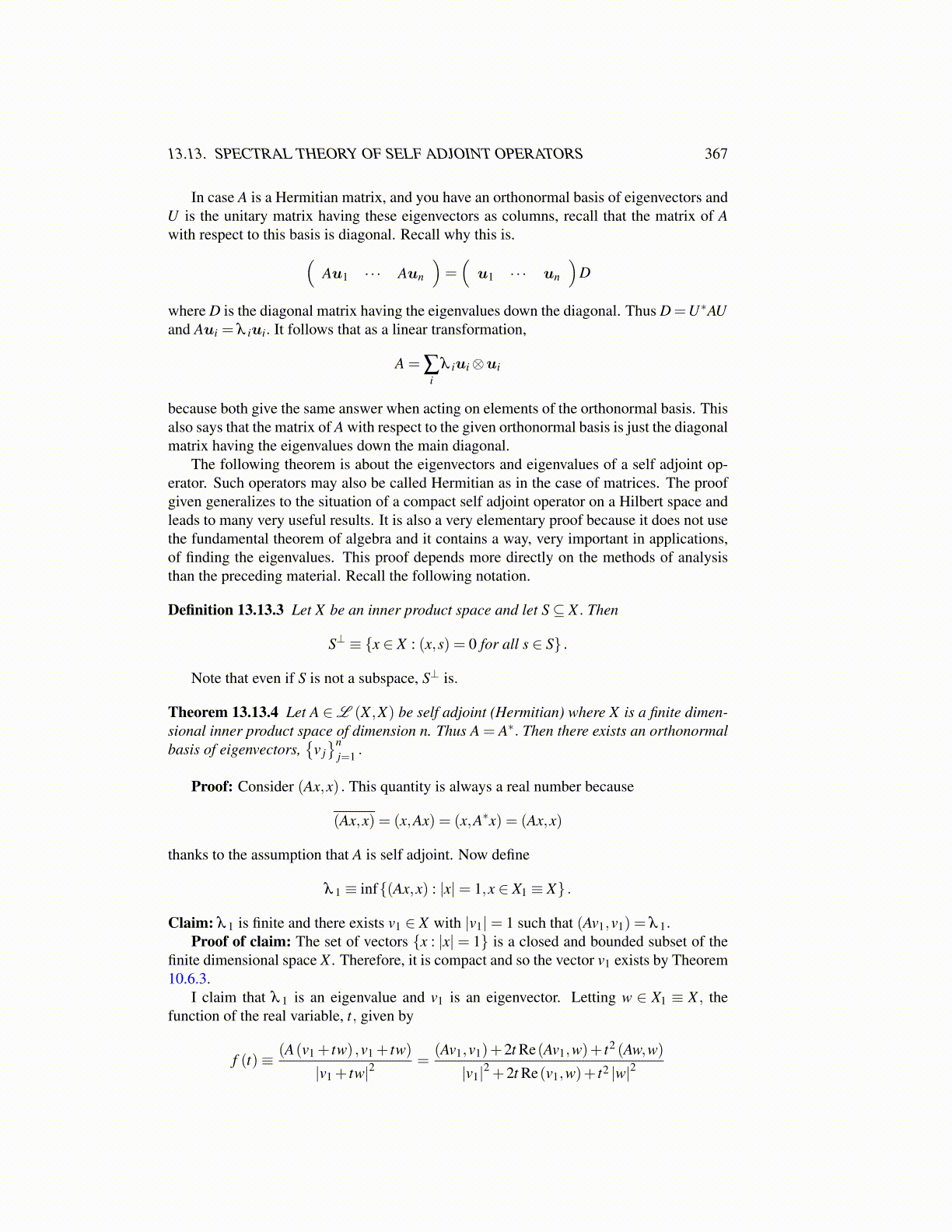
13.13. SPECTRAL THEORY OF SELF ADJOINT OPERATORS 367
In case A is a Hermitian matrix, and you have an orthonormal basis of eigenvectors andU is the unitary matrix having these eigenvectors as columns, recall that the matrix of Awith respect to this basis is diagonal. Recall why this is.(
Au1 · · · Aun
)=(
u1 · · · un
)D
where D is the diagonal matrix having the eigenvalues down the diagonal. Thus D =U∗AUand Aui = λ iui. It follows that as a linear transformation,
A = ∑i
λ iui⊗ui
because both give the same answer when acting on elements of the orthonormal basis. Thisalso says that the matrix of A with respect to the given orthonormal basis is just the diagonalmatrix having the eigenvalues down the main diagonal.
The following theorem is about the eigenvectors and eigenvalues of a self adjoint op-erator. Such operators may also be called Hermitian as in the case of matrices. The proofgiven generalizes to the situation of a compact self adjoint operator on a Hilbert space andleads to many very useful results. It is also a very elementary proof because it does not usethe fundamental theorem of algebra and it contains a way, very important in applications,of finding the eigenvalues. This proof depends more directly on the methods of analysisthan the preceding material. Recall the following notation.
Definition 13.13.3 Let X be an inner product space and let S⊆ X . Then
S⊥ ≡ {x ∈ X : (x,s) = 0 for all s ∈ S} .
Note that even if S is not a subspace, S⊥ is.
Theorem 13.13.4 Let A ∈L (X ,X) be self adjoint (Hermitian) where X is a finite dimen-sional inner product space of dimension n. Thus A = A∗. Then there exists an orthonormalbasis of eigenvectors,
{v j}n
j=1 .
Proof: Consider (Ax,x) . This quantity is always a real number because
(Ax,x) = (x,Ax) = (x,A∗x) = (Ax,x)
thanks to the assumption that A is self adjoint. Now define
λ 1 ≡ inf{(Ax,x) : |x|= 1,x ∈ X1 ≡ X} .
Claim: λ 1 is finite and there exists v1 ∈ X with |v1|= 1 such that (Av1,v1) = λ 1.Proof of claim: The set of vectors {x : |x|= 1} is a closed and bounded subset of the
finite dimensional space X . Therefore, it is compact and so the vector v1 exists by Theorem10.6.3.
I claim that λ 1 is an eigenvalue and v1 is an eigenvector. Letting w ∈ X1 ≡ X , thefunction of the real variable, t, given by
f (t)≡ (A(v1 + tw) ,v1 + tw)
|v1 + tw|2=
(Av1,v1)+2t Re(Av1,w)+ t2 (Aw,w)
|v1|2 +2t Re(v1,w)+ t2 |w|2